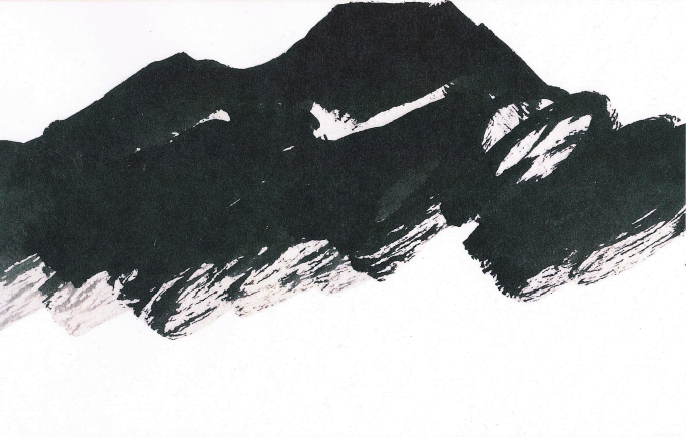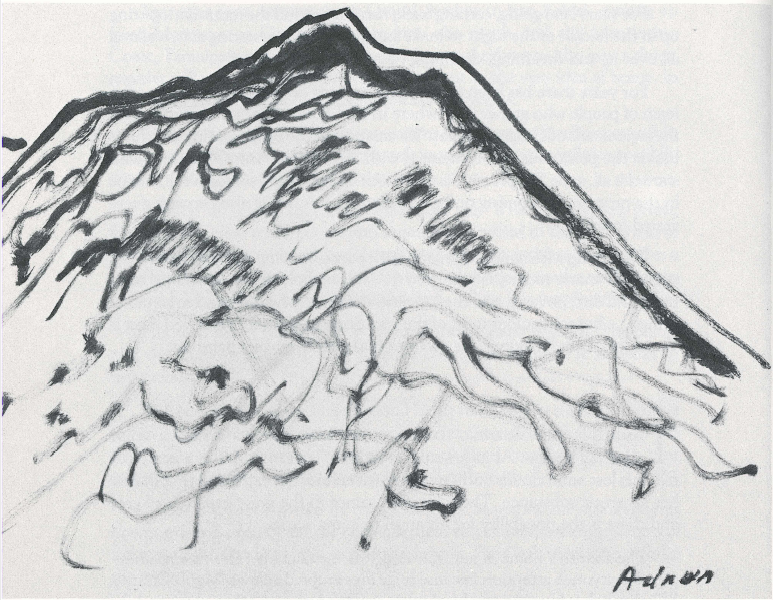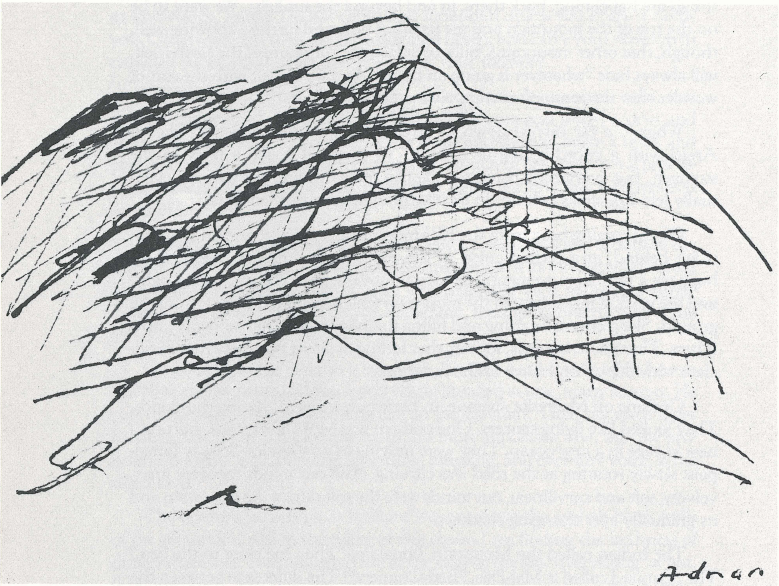
Etel Adnan, Illustration from Journey to Mount Tamalpais (1986)
Journey to Mount Tamalpais reveals Etel Adnan’s deep connection to the Northern California icon. Original in both content and literary structure, the work is generously paired with illustrations by Adnan and explores the importance of Nature as an element of thinking, perception, and identity.
Sometimes, they open a new highway, and let it roll, open wide the earth, shake trees from their roots. The Old Woman suffers once more. Birds leave the edges of the forest, abandon the highway. They go up to mountain tops and from the highest peaks they take in the widest landscapes, they even foresee the space age.
The condor is dying. He used to live on the top of Tamalpais. His square wings used to carry him all over the area: the hills were moving beneath him with silent pride. He used to cut through the clouds like fearful knife. At certain seasons he used to carry the moon between his claws. Now we took over his purpose. We are the ones to go to the Mountain.
This morning I took the card table and put it out on the deck, under the pine trees. On a piece of paper shadows fell. I tried to catch their contours but they were slowly moving, all the time. They made me think of sidewalks on which people pass, swiftly. And the big mountain sent a wild smell of crushed herbs into the air making everything feel slightly off.
Like a chorus, the warm breeze had come all the way from Athens and Baghdad, to the Bay, by the Pacific Route, its longest journey. It is the energy of these winds that I used, when I came to these shores, obsessed, followed by my home-made furies, errynies, and such potent creatures. And I fell in love with the immense blue eyes of the Pacific: I saw its red algae, its blood-colored cliffs, its pulsating breath. The ocean led me to the mountain.
Once I was asked in front of a television camera: “Who is the most important person you ever met?” and I remember answering: “A mountain.” I thus discovered that Tamalpais was at the very center of my being.
Year after year, coming down Grand Avenue in San Rafael, coming up from Monterey or Carmel, coming from the north and the Mendocino Coast, Tamalpais appeared as a constant point of reference, the way a desert traveler will see an oasis, not only for water, but as the very idea of home. In such cases geographic spots become spiritual concepts.
The pyramidal shape of the mountain reveals a perfect Intelligence within the universe. Sometimes its power to melt in mist reveals the infinite possibilities for matter to change its appearance.
I watch its colors: they always astonish me. When it is velvet green, friendly, with clear trails, people and animals are invited to climb, to walk, to breathe. When it is milky white it becomes the Indian goddess it used to be: a huge being with millions of eyes hidden beneath its skin, similar to the image of God I used to have in my childhood days. When it is purple, it radiates.
About three in the afternoon, the mountain starts to swell. The colors and the shadows sharpen. The volumes come into fullness. It all looks so mysterious.
The community sleeps at its feet and in the middle of its trees. Houses live in close friendship with redwoods, pines, and the tallest eucalyptus in the world. There is a smell of wilderness in a civilized county thanks to that majestic being which stands among us in all its beauty.
There is a monkey-tree in the garden. Its branches are monkey-arms opening into clusters of hands. Through them you can sense the purpleness of the mountain, far away, in all its power. Birds fly. They web their ways around the trees and they sing.
It was my destiny to join in a great experience: to live with the mountain and with a team, to encounter them regularly, to know them without ever reaching a point or an end, the way people know a river.
For years I am going, coming back, turning around the mountain, getting up in the middle of the night to make sure it is still there, staring at it, walking all over it, and dreaming, dreaming…
For years there has been an experiment going on at its very base: we are a team of people who gather somewhere in Mill Valley in peaceful parties with the seriousness of children at play. We are most of the time painting but this is beside the point; our involvement is with Perception. Ann O’Hanlon, who started it all, says “To perceive is to be both objective and subjective. It is to be in the process of becoming one with whatever it is, while also becoming separated from it.”
This living with a mountain and with people moving with all their senses open, like many radars, is a journey…melancholy at times: you perceive noise and dirt, poverty, and the loneliness of those who are blind to so many things…but miraculous most of the way. Somehow what I perceived most is Tamalpais. I am “making” the mountain as people make a painting.

Etel Adnan, Illustration from Journey To Mount Tamalpais (1986)
Tamalpais this morning has many shadows like an African beast touched by dew. At its left side, at its base, light unfolds like a peacock’s tail. It is lost amid clouds and says that heaven touches earth and that matter has an erotic substance. There is translucence in the great expanses of grey and there is the possibility for an angel to come across.
The month’s name is autumn and it is melancholy. The mountain escaped everyone’s attention because huge fires erupted all over Marin County. Mike’s ranch is burning and his mother saw the furniture taken away and she could not understand why. “Who is putting on all these lights?” she asked. They had to tell the children that grand’ma had a way of seeing all of her own. The heat went beyond 90 degrees. The summer is never ending, never. The mountain is hidden away by steam, not by fog.
It is rushing toward Kentfield and San Rafael. It is an animal risen from the sea. A sea-creature landed, earth-bound, earth-oriented, maddened by its solidity.
The world around has the darkness of battle-ships, leaveless trees are spearbearers, armor bearers, swords and pikes, the mountain looks at us with tears coming down its slopes.
O impermanence! What a lovely word and a sad feeling. What a fight with termination, with lives that fall into death like cliffs.
O Sundays which are like vessels in a storm, with nothing before and nothing after!
Standing on Mount Tamalpais I am in the rhythms of the world. Everything seems right as it is. I am in harmony with the stars, for the better or the worst. I know. I know. I know.
This morning it is springtime. The softness of the sky envelops the mountain with solicitude. Flowers come out and despair is held at bay…. Memories are as fresh as cool water and a cool breeze floats over one’s fever. The pure blue of heaven is mixed to the clouds. The moment is accepted. The weightlessness of the air is all over.
The mountain slopes converge to the top as if for a tribal gathering. Up there, the open but filled mouth of the volcano speaks back to the sky a tale of past disorder. The fire has left for its own origins: it returned to the sun. The mountain remains in blue silence, in purple desertion, in agony, and nobody knows.
The ocean, below, beats, trying to reach the crater. Tamalpais looks over the hills, the rings of beaches, the screams of so many tempests, the sensuous futility of many storms, and the warm, agonizingly warm, insistence of so many suns. And Tamalpais remains alone, wise in its ingathering, peaceful in its knowledge, happy. Do not climb that mountain unless you know it needs you. Otherwise, you shall die like a diseased raven, and carry your skeleton in crowded streets, and never, never, recover your memory.
Tall trees of so many kinds, from redwoods to manzanitas, oaks, madrones, maples and elms, plants and bushes, flowers and seeds, acorns and grass, they all are the last chance of the earth and they all make a thick and permanent coat, a cover, a bath of perfume, a touch of healing, a royal procession, music and fanfare, they rise and talk to Tamalpais, and sing lullabyes and songs of love.
Only troubadours will save us. San Francisco is always there, outside the place in which we live. It is always like a former city, as if its inhabitants had left on a UFO for another planet. The city remained as a witness, a three dimensional theater stage, a festive, decorated, luminous construction of the mind and of millions of hands.
On KPFA George Jackson is speaking. We hear a tape made while he was still alive and in prison. He has many voices blended in one, many accents. He cuts his sentences short, sounding like an Englishman. Then his voice slides between his lips, and his longest word, his most important one, the one pronounced with a long, burning, agonizing, pleading, and ever sure voice, is the word of love.
The ocean is launching its brilliant waves against the asphalt-black walls of the mountain, and in the night of this ocean I am finding the freshness of dispersed springs. Harbors catch fire at the edge of the sea. Everything, at last, is upside down. The skies are confused with blackness and the water is green like eyes which are cruel and opened on smoke.
I feel trapped in this universe and think of what an anti-universe could mean, which is still a universe; there is no way out.
When the sun sets behind any mountain it looks as if some extraordinary things are happening, back there, in and beyond the sunlight. We want to be on the top of the mountain and see its other side, and further, knowing well, though, that other mountains, hills, or at last, the curvature of the earth itself, will always hide “whatever is going on there.” And we are left with the sort of wonder that the sense of eternity always carries with it.
When the car turned down D Street, the mountain appeared like an Angel with a sword telling us to stop. We received it like a blow in the stomach. But everything being mobile like the earth and the sun, we eventually left Tamalpais behind, in its blue grandeur, its puzzled spirit.
Often, coming back from the Richmond Bridge, just when San Quentin is left behind, at a certain curve of the road, there surges an event, there happens a double movement: the lateral movement of the car, to my right, and the vertical movement of the mountain which seems to be rising from the ground. She seems to be rising and filling a configuration that I already know is hers. That’s where comes, for me, that feeling of latent prophesy that I associate with the vision I have of the mountain.
Cruising on Magnolia Avenue, in Larkspur, we were chasing the clouds .They looked like flying saucers. One of them was Moby Dick itself, starting a new voyage in a new ocean. They were moving in slow circles. So was Tamalpais: slowly rotating as the road was curving. And our minds too were furry, velvety, soft and curvilinear, our minds were the soft skin of the mountain and its gradually ever changing shadows.
The Indian called the Mountain Tamal-Pa, “The One close to the Sea.” The Spaniard called it Mal-Pais, “Bad Country”! The difference between the native and the conqueror is readable in these two different perceptions of the same reality. Let us be the Indian and let be! What is close to the sea shall remain close to the sea.

Etel Adnan, Illustration from Journey To Mount Tamalpais (1986)
This is, then, the place where the line is drawn. Tamalpais is the first of the mountains that constitute the convulsive spine of the American continent, all the way to Tierra del Fuego. It is the beginning of the chain of these greencoated mountains, guerilla-green mountains, green volcanoes, which give their fire and color to revolutions. Tamalpais is their peaceful kin. It is their starting point. Its peace is needed to understand the fire, for nothing can be outside a binary system. (And up north, with Mount Shasta, a new species of mountains develops itself, a different start.) It all is as if the equator of human destiny were foreign to the geological equator: the equator of human history is the latitude on which stands this Mountain that looks like an elephant and feeds on green grass.
I am at the window and Tamalpais looks back at me. I am in pain and it is not. But we are equals tonight.
I am sitting in front of that window as if I were in a movie house. The screen is miles away. Tamalpais is spread over it. I am watching a light-show. Clouds are moving in a peculiar way. I barely see them. All I see is the movement of a large beam of light which slides over the mountain, illuminating it gradually. It is all green, greyish green and bluish green, and the clusters of trees, like woollen balls, roll one after the other.
The large beam comes again. From the West to the East. The beam moves, revealing gradually and exclusively, places of its own choice. It goes on, it seems, for hours. I am amazed, but, more so, I am fulfilled. I am transported outside my ordinary self and into the world as it could be when no watches.
The wind rises from the East. It is blowing toward the Ocean. The lightshow reverses itself.
Tamalpais is jungle-green again. Light moves under and through the clouds. Almost horizontally. Like an army of irregulars. A big grey cloud passes over a huge white one: war and competition in the skies! Among the infinite varieties of blacks, whites, and greys, there are expanses of sulphuric blues. Tamalpais fumes. It is again a volcano.
I read in an old page of my Journals: “March 13th. 1967. Today, all the memories of the universe, as universe, and I, became one. In front of the Mountain.”
To be: the light over there, breaking the clouds, alone in the cool winds, peaceful over the waves, knowing the mountain, and the ocean furiously possessed by its love for water. Drown and do not drown, the mountain is as solid as fog, as translucent as the undertow, as possessed as the ocean, but its travelling is silent and formal, and the ocean is a pure voyage.
A Voyage is like water. A pure experience. What kind of an experience? A JOURNEY. I am water and I move. I need to circle the mountain, because I am water. The mountain has to stay and I have to go, and it all comes to the same thing.
This excerpt was originally published in Adnan, Etel, Journey to Mount Tamalpais (Sausalito: The Post-Apollo Press, 1986), 9–18.